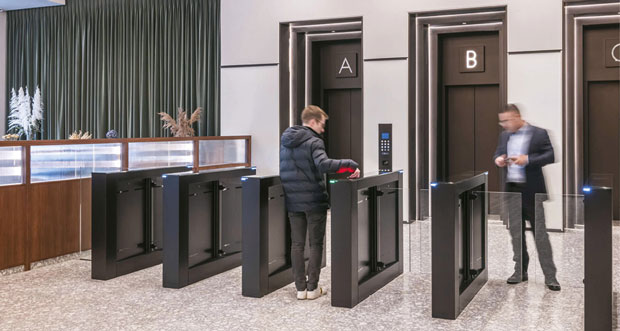Tony Smith, Major Accounts and Marketing Manager at Integrated Design, outlines the benefits of entrance control solutions for multi-tenant offices
Rather than a steady stream of employees throughout the week, workplaces now face greater occupancy peaks and troughs.
As many businesses look to transform their workspaces, what are the security implications for office buildings that either sublet, have multiple tenants, or operate non-traditional usage patterns like shared co-working spaces?
A report from the Office for National Statistics indicated that the great post-pandemic return to the office didn’t take place as many predicted. New ways of working have bedded in, perhaps.
The pandemic saw many companies that own or rent offices scrambling to sublet superfluous space, as home working kicked in. Traditionally, coworking spaces were used by the self-employed, but even before the pandemic, there were indications that this was changing, with large corporations meeting their office needs, in part at least, through this model.
COMMUNICATION WITH MULTIPLE STAKEHOLDERS
In the old days, whoever ran the building ran security, and perhaps liaised occasionally with others, but those others rarely needed to talk to one another. Today, it’s different.
If you sublet part of your leased storey, the sub-tenant might be a firm that handles sensitive documents and requires a higher level of security than you, or it might be the other way round, with them wanting to avoid procedures of yours that they regard as red tape.
If you are in charge of the building, meet regularly with tenants – all together if useful. If done this way, consider formalising those meetings as a building security council. That way everyone knows and agrees what everyone is doing, and is expected to do.
ACCESS CONTROL AND BUILDING MANAGEMENT
It’s pretty standard for office buildings now to have access control software in use. Your actual barrier might be turnstiles, a simple door wired for RFID fobs or something else. Entrance control hardware should be able to integrate with all of the major access control systems, as well as the standard building management systems – the software used to control heating, air-conditioning, lighting and so on.
If you’re the tenant, make use of all the ways these systems can integrate, and if you’re the building owner be aware of how useful tenants and prospective tenants may find this. If you can count the number of people moving through each control point, you can do many things beyond security, such as automatically adjust temperature and turn off unneeded lights to deliver increased building efficiencies.
The building owner should also bear in mind that every security system is only as good as its weakest link. Your perimeter system generally establishes the maximum security any tenant can have.
If your main entrance has a robust security system, tenants might not require any additional layers of security. If they do, however, it is important to recognise that space may prohibit them from adding an entrance control system of their own such as turnstiles, so other access control systems could be an option.
DETERMINE YOUR SECURITY NEEDS
Each stakeholder then needs to decide what security needs they have. How much does it matter to you to control in-building movement by staff and visitors, including of other companies? Do you want to accurately count people as they move, for security or building management purposes? For internal doors, an optical only system can deliver multiple benefits in a small physical housing, and without slowing down the flow of pedestrian traffic. Another point to bear in mind includes thinking about how the system deals with garage entry visitors.
And finally, watch out for how things work in practice. For example, if the building owner or main tenant above you, has low security concerns, they may have slipped into a norm of waving people through to ease bottlenecks. By putting a robust system of emergency procedures and drills in place you can ensure that everyone helps support safe and secure access and egress within the entire site.





